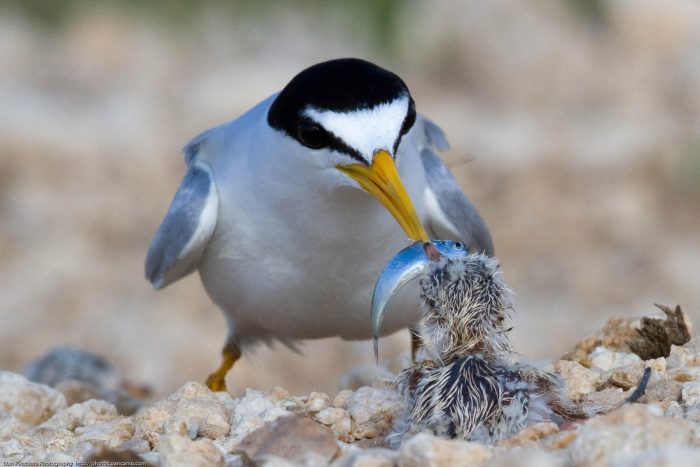Least Tern
Sternula antillarum
In the spring and summer, the least tern can be identified by its black crown and nape, which contrast with its white forehead.
This section shows one large critter image at a time. Use the thumbnails that follow to select a specific image to display here.

This gallery contains a grid of small thumbnails. Selecting a thumbnail will change the main image in the preceding section.
Appearance
Least terns weigh approximately one ounce and measure nine inches in length. Females are slightly smaller than males. The least tern's body is slate gray on top and white below, with pointed wings and forked tail. Its bill and feet are yellow. It can be identified in spring and summer by its black crown and nape, which contrast with its white forehead. The black edge of its outer wing can be clearly seen in flight.
Feeding
Least terns feed on small fish, crustaceans and insects. They hover over the water and dive or skim for prey.
Predators
Predators include large birds, including American kestrels, great blue herons, crows and owls, and small mammals, including raccoons, skunks, foxes, coyotes, cats and dogs.
Flight
The least tern is known for its delicate, graceful and buoyant flight. Its wingbeats are rapid.
Voice
Typically, the least tern's call is a sharp kip-kip-kip. When alarmed, call is a sharp zreep or a high-pitched kee-zink, kee-zink.
Reproduction and life cycle
These birds breed in colonies of up to 200 birds. They nest on sandy or gravelly beaches and riverbanks. Nests are scraped in sand and may be lined with shell, gravel or other debris. Both sexes build nests, incubate and care for young. Eggs are laid in clutches of two from late May through June and hatch in 21 days.
Chicks leave the nest a few days after hatching, but adults continue to care for them, leading them to shelter in nearby grasses and bringing them food. Chicks fledge in approximately 20 days, but can stay with adults for up to three months. The average lifespan is 15 years, although studies have found individuals up to 21 years old.
Did you know?
- Least terns’ nesting habitat often overlaps with human recreation and residential areas. Because of human interference and habitat loss, least terns are classified as threatened, endangered or of concern in most states.
- Terns live in defensive colonies: it is common for adults to screech, mob, defecate on and dive at intruders. Because of this, piping plovers (another endangered beach-nesting bird) are often seen nesting near least tern colonies.
- Until protective legislation was passed in 1918, the least tern population was almost completely lost due to the use of its feathers in women's hats.
Sources and additional information
- Least Tern – The Cornell Lab of Ornithology
- Least Tern – The New York Department of Environmental Conservation
- Least Tern – The New Jersey Division of Fish and Wildlife
